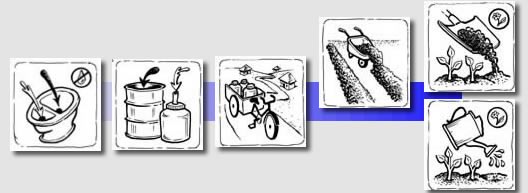Difference between revisions of "Sanitation Portal"
| Line 1: | Line 1: | ||
{|border="0" width="100%" | {|border="0" width="100%" | ||
| − | | | + | |Este portal se describen las tecnologías de saneamiento que se puede aplicar desde los hogares a nivel de las aldeas.|| |
{| width="100%" border="1" cellpadding="5" cellspacing="0" | {| width="100%" border="1" cellpadding="5" cellspacing="0" | ||
|colspan="3" style="background:#fdfe97" |Languages available / langues disponibles / idiomas disponibles | |colspan="3" style="background:#fdfe97" |Languages available / langues disponibles / idiomas disponibles | ||
| Line 9: | Line 9: | ||
|} | |} | ||
| − | + | Un sistema de saneamiento no consiste en una única tecnología se describe a continuación. Un sistema de saneamiento completa se compone de una cadena de tecnologías, cada uno cuidando de una función específica, como el sanitario, el transporte, y tratamiento. Cada tecnología a continuación se dedica a una función particular en esta cadena. Un ejemplo se da al final de esta página. | |
Revision as of 13:15, 28 February 2011
| Este portal se describen las tecnologías de saneamiento que se puede aplicar desde los hogares a nivel de las aldeas. |
|
|||||||
Un sistema de saneamiento no consiste en una única tecnología se describe a continuación. Un sistema de saneamiento completa se compone de una cadena de tecnologías, cada uno cuidando de una función específica, como el sanitario, el transporte, y tratamiento. Cada tecnología a continuación se dedica a una función particular en esta cadena. Un ejemplo se da al final de esta página.
Sanitation technologies
Below, sanitation technologies are presented in different functional groups: User interface (Toilets, urinals, handwashing), Collection and Storage / Local Treatment, Conveyance, (semi-) Centralized Treatment, and Use of products / disposal.
Sanitation systems
In this section we give an example of a complete sanitation system, which consists of a chain of technologies. Reading the icons in the illustration below from the left to the right we have a Urine Diverting Dry Toilet connecting to Storage tanks, where the faeces are taken away through Human-Powered Emptying and Transport to be processed through Co-composting and then finally be used through Application of Compost - Eco-Humus and the Application of Urine.
The table below lists eight different examples of sanitation systems, going from very simple to more complex. Of course, many other systems are possible, depending on the local context.
| 1 Single Pit System | 2 Waterless System with Alternating Pits | 3 Pour Flush System with Twin Pits | 4 Waterless System with Urine Diversion | 5 Blackwater Treatment System with Infiltration | 6 Blackwater Treatment System with Sewerage | 7 (Semi-) Centralized Treatment System | 8 Sewerage System with Urine Diversion |
Acknowledgements
- The majority of the material in this portal was adapted from: Tilley, E. et al. (2008). Compendium of Sanitation Systems and Technologies. Eawag: The Swiss Federal Institute of Aquatic Science and Technology, Dübendorf, Switzerland.
- Currently, WASTE is working on a Sanitation Decision Support tool, which will be integrated in this portal in the near future.
- Smart Sanitation Solutions produced in collaboration with Netherlands Water Partnership, WASTE, PRACTICA, IRC International Water and Sanitation Centre, SIMAWI and Partners voor Water

